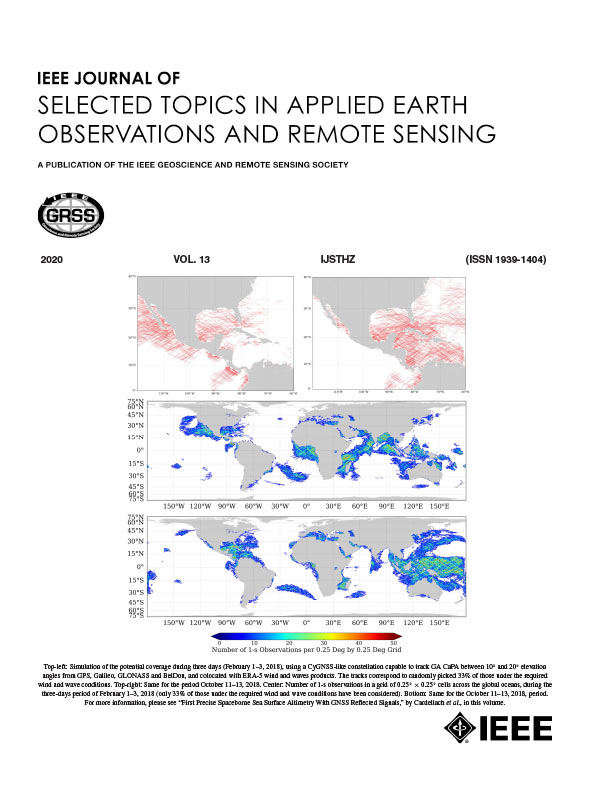Infrared Small Target Detection via Two-Stage Feature Complementary Improved Tensor Low-Rank Sparse Decomposition
IF 4.7
2区 地球科学
Q1 ENGINEERING, ELECTRICAL & ELECTRONIC
IEEE Journal of Selected Topics in Applied Earth Observations and Remote Sensing
Pub Date : 2024-09-18
DOI:10.1109/JSTARS.2024.3463017
引用次数: 0
Abstract
Infrared small target detection has been widely used in military and civil fields. However, due to the insufficient feature integration capabilities of existing methods, effectively separating strong background clutter and targets in complex scenes remains difficult. To address this issue, we propose a two-stage feature complementary improved tensor low-rank sparse decomposition (TLRSD) method. The detection process is divided into two stages: tensor initialization and tensor decomposition, effectively integrating local and nonlocal features. In the tensor initialization stage, inspired by the local saliency of the target and the local consistency of the background, we design a three-layer directional filtering (TLDF) operator for preliminary clutter suppression and target enhancement. Then, to promote the complementary advantages of local and nonlocal features, we refer to the TLDF and the original image to provide a targeted initialization strategy for the TLRSD model. In the tensor decomposition stage, we develop a robust partial sum of the tubal nuclear norm as a nonconvex approximation of tensor rank, which can adaptively adjust the singular value distribution, thus adapting to diversity scenes. Meanwhile, we finely adjust the balance between low-rank and sparse components in the model-solving process through a nonlinear reweighting strategy, accelerating the optimization convergence speed and improving the model's background recovery ability. Extensive experiments on five practical datasets demonstrate that the proposed method is more effective and robust compared to ten state-of-the-art approaches.通过两阶段特征互补改进张量低阶稀疏分解进行红外小目标探测
红外小目标探测已广泛应用于军事和民用领域。然而,由于现有方法的特征整合能力不足,有效分离复杂场景中的强背景杂波和目标仍然困难重重。针对这一问题,我们提出了一种两阶段特征互补改进张量低阶稀疏分解(TLRSD)方法。检测过程分为两个阶段:张量初始化和张量分解,有效地整合了本地和非本地特征。在张量初始化阶段,受目标局部显著性和背景局部一致性的启发,我们设计了一种三层定向滤波(TLDF)算子,用于初步抑制杂波和增强目标。然后,为了促进局部和非局部特征的优势互补,我们参考 TLDF 和原始图像,为 TLRSD 模型提供了有针对性的初始化策略。在张量分解阶段,我们开发了一种稳健的管核规范部分和,作为张量秩的非凸近似值,可以自适应地调整奇异值分布,从而适应多样性场景。同时,在模型求解过程中,我们通过非线性重权策略精细调整了低秩成分和稀疏成分之间的平衡,加快了优化收敛速度,提高了模型的背景恢复能力。在五个实际数据集上的广泛实验证明,与十种最先进的方法相比,所提出的方法更加有效和稳健。
本文章由计算机程序翻译,如有差异,请以英文原文为准。
求助全文
约1分钟内获得全文
求助全文
来源期刊
CiteScore
9.30
自引率
10.90%
发文量
563
审稿时长
4.7 months
期刊介绍:
The IEEE Journal of Selected Topics in Applied Earth Observations and Remote Sensing addresses the growing field of applications in Earth observations and remote sensing, and also provides a venue for the rapidly expanding special issues that are being sponsored by the IEEE Geosciences and Remote Sensing Society. The journal draws upon the experience of the highly successful “IEEE Transactions on Geoscience and Remote Sensing” and provide a complementary medium for the wide range of topics in applied earth observations. The ‘Applications’ areas encompasses the societal benefit areas of the Global Earth Observations Systems of Systems (GEOSS) program. Through deliberations over two years, ministers from 50 countries agreed to identify nine areas where Earth observation could positively impact the quality of life and health of their respective countries. Some of these are areas not traditionally addressed in the IEEE context. These include biodiversity, health and climate. Yet it is the skill sets of IEEE members, in areas such as observations, communications, computers, signal processing, standards and ocean engineering, that form the technical underpinnings of GEOSS. Thus, the Journal attracts a broad range of interests that serves both present members in new ways and expands the IEEE visibility into new areas.

 求助内容:
求助内容: 应助结果提醒方式:
应助结果提醒方式:


